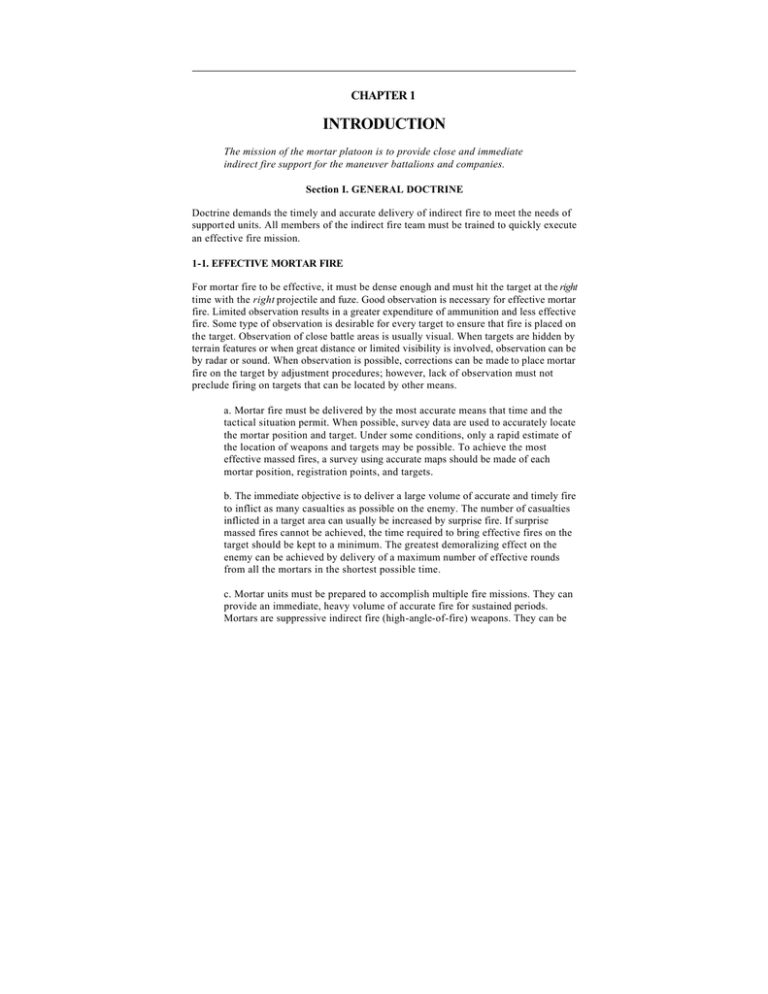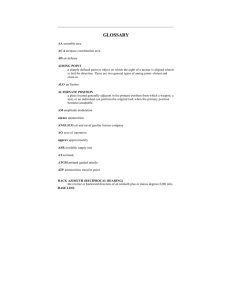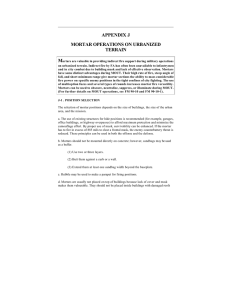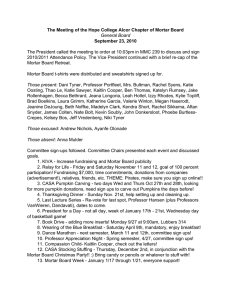INTRODUCTION CHAPTER 1
advertisement

CHAPTER 1 INTRODUCTION The mission of the mortar platoon is to provide close and immediate indirect fire support for the maneuver battalions and companies. Section I. GENERAL DOCTRINE Doctrine demands the timely and accurate delivery of indirect fire to meet the needs of supported units. All members of the indirect fire team must be trained to quickly execute an effective fire mission. 1-1. EFFECTIVE MORTAR FIRE For mortar fire to be effective, it must be dense enough and must hit the target at the right time with the right projectile and fuze. Good observation is necessary for effective mortar fire. Limited observation results in a greater expenditure of ammunition and less effective fire. Some type of observation is desirable for every target to ensure that fire is placed on the target. Observation of close battle areas is usually visual. When targets are hidden by terrain features or when great distance or limited visibility is involved, observation can be by radar or sound. When observation is possible, corrections can be made to place mortar fire on the target by adjustment procedures; however, lack of observation must not preclude firing on targets that can be located by other means. a. Mortar fire must be delivered by the most accurate means that time and the tactical situation permit. When possible, survey data are used to accurately locate the mortar position and target. Under some conditions, only a rapid estimate of the location of weapons and targets may be possible. To achieve the most effective massed fires, a survey using accurate maps should be made of each mortar position, registration points, and targets. b. The immediate objective is to deliver a large volume of accurate and timely fire to inflict as many casualties as possible on the enemy. The number of casualties inflicted in a target area can usually be increased by surprise fire. If surprise massed fires cannot be achieved, the time required to bring effective fires on the target should be kept to a minimum. The greatest demoralizing effect on the enemy can be achieved by delivery of a maximum number of effective rounds from all the mortars in the shortest possible time. c. Mortar units must be prepared to accomplish multiple fire missions. They can provide an immediate, heavy volume of accurate fire for sustained periods. Mortars are suppressive indirect fire (high-angle-of-fire) weapons. They can be employed to neutralize or destroy area or point targets, screen large areas with smoke, and to provide illumination or coordinated HE/illumination. d. In the armor and mechanized infantry battalions, mortars are normally fired from mortar carriers; however, they maintain their capability to be groundmounted. Firing from the carrier permits rapid displacement and quick reaction. 1-2. MORTAR POSITIONS Mortars should be employed in defilade to protect them from enemy direct fire and observation, and to take the greatest advantage of their indirect fire role. Although the use of defilade precludes sighting the weapons directly at the target (direct lay), it is necessary for survivability. Because mortars are indirect fire weapons, special procedures ensure that the weapon and ammunition settings used will cause the projectile to burst on or above the target. A coordinated effort by the indirect fire team ensures the timely and accurate engagement of targets. Section II. INDIRECT FIRE TEAM Indirect fire procedure is a team effort (Figure 1-1). Since the mortar is normally fired from defilade (where the crew cannot see the target), the indirect fire team gathers and applies the required data. The team consists of an FO, an FDC, and the gun squad. Figure 1-1. Indirect fire team. 1-3. APPLICATIONS To successfully accomplish missions from a defilade position, certain steps must be followed in applying essential information and engaging targets. • • • • Locate targets and mortar positions. Determine chart data (direction, range, and vertical interval from mortars to targets). Convert chart data to firing data. Apply firing data to the mortar and ammunition. 1-4. TEAM MISSION The team mission is to provide accurate and timely response to the unit it supports. Effective communication is vital to the successful coordination of the efforts of the indirect fire team. a. The forward observer (FO), as part of the fire support team (FIST), is normally provided by a direct support (DS) artillery battalion. One 4-man FO team supports each mechanized infantry company. The light infantry company is supported by a 10-man company-level FO team. The team is composed of a lieutenant, staff sergeant, radio-telephone operator, driver with a HMMWV at company headquarters, and six FOs (one 2-man team for each infantry platoon in the company). The FO’s job is to find and report the location of targets, and to request and adjust fire. b. The fire direction center (FDC) has two computer personnel who control the mortar firing. They convert the data in a call for fire from the FO into firing data that can be applied to the mortars and ammunition. c. A mortar squad consists of three to five mortarmen, depending on the system. The squad lays the mortar and prepares the ammunition, using the data from the FDC fire command. When those data have been applied, the squad fires the mortar--it must also be able to fire without an FDC. Section III. SAFETY PROCEDURES Although safety is a command responsibility, each member of the mortar fire team must know safety procedures and enforce them. Misfire procedures discussed in this field manual are based on peacetime operations. (See ARTEP 7-90-Drill for combat operations.) 1-5. DUTIES OF THE SAFETY OFFICER AND SUPERVISORY PERSONNEL Safety officers must help commanders meet the responsibility of enforcing safety procedures. The safety officer has two principal duties: first, to ensure that the section is properly laid so that when rounds are fired, they land in the impact area; second, to ensure that all safety precautions are observed at the firing point. a. Duties Before Departing for Range . The safet y officer must read and understand the following: • • • • AR 385-63. Post range and terrain regulations. The terrain request of the firing area to know safety limits and coordinates of firing positions. Appropriate field and technical manuals pertaining to weapons and ammunition to be fired. b. Duties of Supervisory Personnel. Supervisory personnel must know the immediate action to be taken for firing accidents. The following is a list of minimum actions that must be taken if an accident occurs. (1) Administer first aid to injured personnel, then call for medical assistance. (2) If the ammunition or equipment presents further danger, move all personnel and equipment out of the area. (3) Do not change any settings on or modify the position of the mortar until an investigation has been completed. (4) Record the ammunition lot number involved in the accident or malfunction and report it to the battalion ammunition officer. If a certain lot number is suspected, its use should be suspended by the platoon leader. c. Mortar Range Safety Checklist. A mortar range safety checklist can be written for local use. The following is a suggested checklist, which can also include three columns on the right titled "Yes," "No," and "Remarks." (1) Items to check before firing. (a) Is a range log or journal maintained by the officer in charge? (b) Is radio or telephone communication maintained with-• • • • • Range control? Unit S3? Firing crews? Forward observers? Road or barrier guards? (c) Are the required emergency personnel and equipment present on the range? • • • Properly briefed and qualified medical personnel. A wheeled or tracked ambulance. Fire-fighting equipment. (d) Are the following range controls and warning devices available, readily visible, and in use during the firing exercise? • • • Barrier/road guards briefed and in position. Road barriers in position. Red range flag in position. • • • Blinking red lights for night firing. Signs warning trespassers to beware of explosive hazards and not to remove duds or ammunition components from ranges. Noise hazard warning signs. (e) Are current copies of the following documents available and complied with? • • • • AR 385-63. Technical and field manuals pertinent to the mortar in use. Appropriate firing tables. Installation range regulations. (f) Are the following personal safety devices and equipment available and in use? • • • Helmets. Protective earplugs. Protective earmuffs. (g) Is the ammunition the correct caliber, type, and quantity required for the day’s firing? Are the rounds, fuzes, and charges-• • • • • • Stored in a location to minimize possible ignition or detonation? Covered to protect them from moisture and direct sunlight? Stacked on dunnage to keep them clear of the ground? Strictly accounted for by lot number? Exposed only immediately before firing? Stored separately from ammunition and protected from ignition? (h) Has the range safety officer verified the following? • • • • • • • The mortar safety card applies to the unit and exercise. The firing position is correct and applies to the safety card, and the base mortar is within 100 meters of the surveyed firing point. Boresighting and aiming circle declination are correct. The plotting board or MBC is correct. The FO has been briefed on the firing exercise and knows the limits of the safety fan. The lay of each mortar is correct. The safety stakes (if used) are placed along the right and left limits. • • • • • Each safety NCO and gunner has been informed in writing of the following: o Right and left limits (deflection). o Maximum elevation and charge. o Minimum elevation and charge. o Minimum time setting for fuzes. All personnel at the firing position have been briefed on safety misfire procedures. If the safety card specified overhead fire, firing is IAW AR 385-63. The mortars are safe to fire by checking-o Mask and overhead clearance. o Weapons and ammunition. o Properly seated sights on weapons. o Carefully positioned lights on the sights and aiming stakes for night firing. T he OIC is informed that the range is cleared to fire and that range control has placed it in a "wet" status. (2) Items to check during firing. (a) Are the unit personnel adhering to the safety regulations? (b) Is each charge, elevation, and deflection setting checked before firing? (c) Does the safety NCO declare the mortar safe to fire before the squad leader announces, "Hang it, fire"? (d) Do all gun settings remain at last data announced until a subsequent fire command is issued by the FDC? (e) Are ammunition lots kept separate to avoid the firing of mixed lots? (3) Items to check after firing. (a) Have the gunners and safety NCO verified that no loose propellants are mixed with the empty containers? (b) Has the safety NCO disposed of the unused propellants? (c) Has the unused ammunition been inventoried and repacked properly? (d) Have the proper entries been made in the equipment logbook (DA Form 2408-4). (e) Has the OIC or safety officer notified range control of range status and other required information? (f) Has a thorough range police been conducted? d. Safety Card. The safety officer should receive a copy of the safety card from the OIC before allowing fire to begin. He constructs a safety diagram based on the information on the safety card. A safety card should be prepared and approved for each firing position and type of ammunition used. The form of the card depends upon local regulations (training list, overlay, range bulletin). Even without a prescribed format, it should contain the following: • • • • • • • Unit firing or problem number. Type of weapon and fire. Authorized projectile, fuze, and charge zone. Grid of the platoon center. Azimuth of left and right limits. Minimum and maximum ranges and elevations. Any special instructions to allow for varying limits on special ammunition or situations. e. Safety Diagram. The safety officer, on receipt of the safety card, constructs a safety diagram. The safety diagram is a graphic portrayal of the data on the safety card, which need not be drawn to scale but must accurately list the sight settings that delineate the impact area. The diagram serves as a convenient means of checking the commands announced to the gun crews against those commands that represent the safety limits. (1) The diagram shows the right and left limits, expressed in deflections corresponding to those limits; the maximum and minimum elevations; and the minimum fuze settings (when applicable) for each charge to be fired. The diagram also shows the minimum and maximum range lines, the left and right azimuth limits, the deflections corresponding to the azimuth limits, and the direction on which the guns are laid. The safety diagram must show only necessary information. (2) To accurately complete a safety diagram, the safety officer must use the information supplied by range control or, in the example in Figure 1-2, the safety card. 1. Enter the known data, supplied from the safety card, on the safety diagram. 2. Determine the azimuth center sector. 3. 4. 5. 6. 7. 8. Determine mounting azimuth. Determine mils left and right deviations of mounting azimuth. Determine referred deflection. Determine deflections to left and right limits. Determine minimum and maximum charges and elevations. If illumination is to be used, determine from the appropriate firing tables the minimum and maximum charges and ranges to burst and impact for the canister. The minimum range is used to determine the minimum charge and range to burst. The maximum range is used to determine the maximum charge and range to impact. EXAMPLE 1. Place all data supplied by the safety card on the safety diagram at this time. 2. Add the right and left limits and divide by 2 to compute the azimuth center sector. RIGHT LIMIT LEFT LIMIT TOTAL 0920 + 0500 = 1420 TOTAL = 1420 divided by 2 = 0710 3. The answer 0710 is the azimuth center sector to use. 4. Determine mounting azimuth. For all mortars (M16 plotting board), round off to nearest 50 mils; for example, 0710 = 0700. 5. Determine referred deflection. It can be any number, but 2800 is normally used. 6. Determine referred deflection for left and right limits. a. Determine the number of mils from the mounting azimuth to the left limit. MOUNTING AZIMUTH 0700 LEFT LIMIT - 0500 MILS TO LEFT LIMIT = 0200 b. Using the LARS rule for referred deflection, calculate the left limit deflection. CENTER OF SECTOR REFERRED DEFLECTION 2800 MILS TO LEFT LIMIT + 0200 LEFT LIMIT DEFLECTION = 3000 c. Determine the number of mils from the mounting azimuth to the right limit. RIGHT LIMIT 0920 MOUNTING AZIMUTH - 0700 MILS TO RIGHT LIMIT = 0220 d. Using the LARS rule for referred deflection, calculate the right limit deflection. CENTER OF SECTOR REFERRED DEFLECTION 2800 MILS TO RIGHT LIMIT - 0220 RIGHT LIMIT DEFLECTION = 2580 7. Determine minimum and maximum charges and elevations by using the firing tables for the mortar being fired. Note : When determining deflections for 4.2-inch mortars, add the minimum drift for the minimum range to the left limit deflection and maximum drift for the maximum range to the right limit deflection. This is the responsibility of the section sergeant. Figure 1-2. Example of how to complete a safety diagram (continued). 1-6. AMMUNITION CARE AND HANDLING A complete round of mortar ammunition contains all the components needed to get the round out of the tube and to burst it at the desired place and time. The key to proper ammunition functioning is protection. Rounds prepared but not fired should be placed back in their containers, fin end first. Safety is always a matter of concern for all section personnel, and it requires special attention where ammunition is concerned. Supervision is critical, because improper care and handling can cause serious accidents as well as inaccurate fire. Following are some of the principles of proper ammunition handling. • • • • • Never tumble, drag, throw, or drop individual cartridges or boxes of cartridges. Do not allow smoking, open flames, or other fire hazards around ammunition storage areas. Inspect each cartridge before it is loaded for firing. Dirty ammunition can damage the weapon or affect the accuracy of the round. Keep the ammunition dry and cool. Never make unauthorized alterations or mix components of one lot with another. Note : For care and handling of specific mortar rounds, see corresponding chapter in this manual. a. Projectiles/Cartridges. Each projectile must be inspected to ensure that there is no leakage of the contents, and that the projectile is correctly assembled. The HE 4.2-inch mortar projectiles are issued without a fuze. Each is issued with a removable supplementary charge so that it can be used with an impact, mechanical, or VT (proximity) fuze. b. Burning of Unused Propelling Charges. Mortar increments and propelling charges are highly flammable, and they must be handled with extreme care to preclude exposure to heat, flame, or any spark-producing source. This includes exposure to the hot residue from burning increments or propelling charges that float downward after a cartridge leaves the barrel. Like other types of ammunition, increments and propelling charges must be kept cool and dry. Storing these items inside the ammunition boxes until needed is an effective way to prevent premature combustion. (1) Unused charges must not be saved but should be removed to a storage area until they can be burned or otherwise disposed of. (2) Burning increments create a large flash and a lot of smoke. In a tactical environment, the platoon leader must ensure that burning increments do not compromise camouflage and concealment. The burning of increments in a dummy position, if established, can aid in the deception effort. The safety officer, in a range environment, supervises the disposal of unused propellant increments. c. Fuzes. Never fire a round with a fuze that is not authorized for that round. Specific fuzes available for each weapon system are discussed in this manual. (1) Fuzes are sensitive to shock and must be handled with care. Before fuzing a round, inspect the threads of the fuze and fuze well for cleanliness and crossed threads. The fuze should be screwed into the fuze well slowly until resistance is met and then firmly seated with a sharp twist of the M25 or M18 fuze wrench, as appropriate. WARNING Premature detonation may occur if a fuze is not properly seated. (2) To prevent accidental functioning of the point-detonating elements of fuzes of the M524 series, the fuzes must not be dropped, rolled, or struck under any circumstances. Any mechanical-time fuze that is set and modified must be reset to SAFE, and the safety wires (if applicable) must be replaced before the fuze is repacked in the original carton. (3) All primers must be inspected before use for signs of corrosion. If a seal has been broken, it is likely that the primer has been affected by moisture and should be turned in. d. Segregation of Ammunition Lots. Different lots of propellant burn at different rates and give slightly different effects in the target area. Therefore, the registration corrections derived from one lot do not always apply to another. Ammunition MUST be segregated by lot and weight zone (square weight [4.2inch mortar only]). In the field storage area, on vehicles or in a dump, ammunition lots should be roped off with communications wire or twine and conspicuously marked with a cardboard sign or other marker. 1-7. FIELD STORAGE OF AMMUNITION Most ammunition components can be stored at temperatures as low as -80 degrees F for not longer than three days and as high as 160 degrees F for not longer than four hours. a. The greatest hazards to ammunition in the storage area are weather, enemy fire, NBC contamination, improper handling, and accidental fires. Regardless of the method of storage, those hazards must be considered. Some general considerations that apply to storage are as follows: (1) Stack ammunition by type, lot number, and weight zone (Figure 1-3). Note : WP ammunition must be stacked fuze-end up. Figure 1-3. Stacked ammunition. (2) If ammunition is being stored on the ground, use good strong dunnage at least 6 inches under each stack. (3) Keep the ammunition dry and out of direct sunlight by storing it in a vehicle or covering it with a tarpaulin. Be sure adequate ventilation is provided around ammunition and between covering material and ammunition. (4) Protect ammun ition as much as possible from enemy indirect fires. If sandbags are used for protection, keep the walls at least 6 inches from the stacks and the roof at least 18 inches from the stacks to ensure proper ventilation. b. An increase in malfunctions can occur with some proximity fuzes if fired when the temperature is below 0 degrees F or above 120 degrees F. Powder temperature affects the muzzle velocity of a projectile and is of frequent concern to the FDC.


